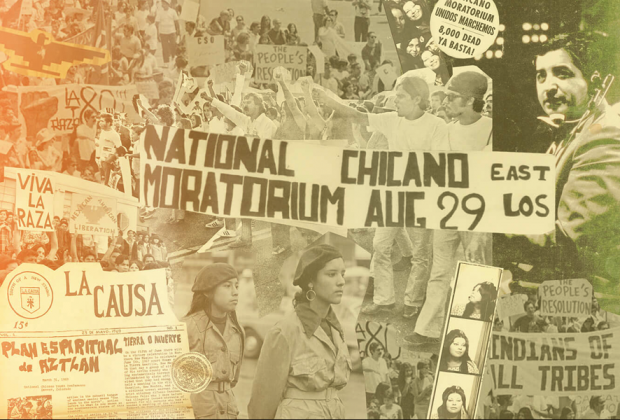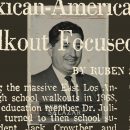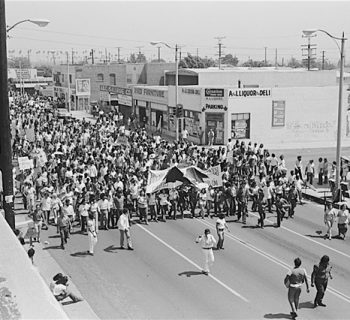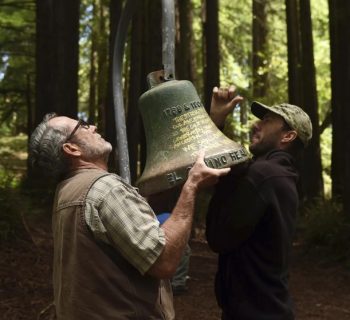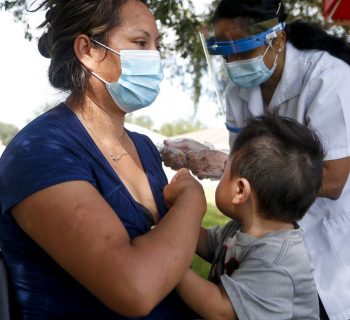It started as a peace march. But for the Moratorium generation, the day left protesters dismayed, disappointed and angry.
By D
The night before Aug. 29, 1970, a date that would be remembered for dashed hopes and heartbreak, then-9-year-old Consuelo Flores went to bed early, excited for what was to come: a celebratory marcha for peace.
It felt like it was going to be a party in her East L.A. neighborhood. Her family made protest signs. She decided to wear her prized red tennis shoes, “the ones that as a child you say, ‘Oh, these make me run fast, and you can run higher.’ ”
The National Chicano Moratorium Against the Vietnam War in East Los Angeles would become the biggest gathering of Mexican American demonstrators in U.S. history to that point, with about 20,000 people parading down Whittier Boulevard to what was then called Laguna Park — before widespread violence erupted when sheriff’s deputies stormed the park and skirmishes followed. Patrol cars and buildings were set on fire.
The chaos would lead to three deaths, including that of Times journalist Ruben Salazar.
For many in Los Angeles, the march and its chaotic aftermath marked both the peak and the beginning-of-the-end of the Chicano movement.
As the Moratorium’s 50th anniversary approaches, schools, cultural groups, historians, artists and activists are reexamining how the events of Aug. 29, 1970, still echo politically, socially and culturally, and how in many uncanny ways, the issues at play back then — injustice and police brutality — are reflected on the streets of L.A. now.
It was a “moratorium” because it was a call to suspend, so to speak, the loss of brown lives in the slog of the Vietnam War, half a planet away. Two times as many people with Spanish surnames were dying at its peak in proportion to their population in the Southwest, according to studies by academic Ralph C. Guzman, a future deputy assistant secretary of State. For a growing and increasingly assertive population of Mexican Americans in California and the U.S. Southwest, those numbers didn’t sit well.
One of Flores’ older brothers, Luis, had returned from serving. He was “changed,” she recalled. The morning of the Moratorium, Flores waited for the march to pass their house at Brannick Avenue, and then joined with some of her siblings.
“I knew as a 9-year-old that this was a big thing, and the whole community was taking part in it,” said Flores, now 59. “I was excited, so I wore my red tennis shoes.”
At Laguna Park, before the stage, she went barefoot to rest in the grass. Whole families turned out. Folkloric dancers took the stage and the mood was joyous.
At some point after the rally started, deputies responded to a ruckus at a liquor store nearby, where crowds were attempting to buy beverages. Fearing shoplifting, the owners locked people inside until all of them completed purchases, according to accounts. Then the owners called the Sheriff’s Department, which to this day polices unincorporated East Los Angeles.

To the deputies that first arrived, the scene looked like “looting.” Someone threw a bottle. An order came to clear the park a block away. Deputies formed a line. Then they began advancing, batons out.
“I could feel the ground underneath my butt was shaking,” Flores recalled. “And before I could put my shoes back on, my sister was grabbing my arm and yanking me up.”
She managed to slip on her shoes without tying them, just enough to move. They began running, dodging “bottles, sticks, rocks.” Flores remembered smoke — tear gas, shot into the crowds. Untold numbers of protesters were injured by deputies or while fleeing.
“I’m 9 years old, and I’m seeing the cop who’s supposed to protect me, whacking” a young man, she recalled. “My shoes just fall off, and I just keep running, I’m running with my bare feet, so now my feet are burning too, and ... I’m just trying to get home.”
Salazar’s killing, by a tear-gas projectile shot through the curtained doorway of the Silver Dollar Bar & Cafe by Deputy Thomas Wilson, the acting sergeant at the scene, rattled East L.A. and reverberated nationally. Salazar’s voice had begun to challenge mainstream interpretations of the political ferment brewing in major barrios in the big cities of the West, from Denver to San Diego and El Paso and everywhere in between. Through spirited columns, Salazar became the de facto chronicler of the Latino civil rights movement at the time.
“To this day, even talking to you about it, right now I want to cry,” Flores said from her home in South L.A. “It was a traumatic event. It also indelibly marked my life, forever, because it was such an unjust experience that I witnessed.”

Among the marchers was Gloria Molina, 72, who would become the first Latina elected to the California Assembly and the Los Angeles County Board of Supervisors. “We were really there to have a peaceful march, and we wanted to make a point,” she said. “And instead our community was destroyed, Salazar was killed, and hundreds of people were hurt by the batons. They came in with such force.”
Molina doesn’t regard the Moratorium as a personal turning point; she had already embraced political activism. But she’ll never forget what she saw.
“It was, I guess, a loss of innocence,” Molina said. “I certainly felt what I was doing was right, and I certainly felt that that was violated, and consequently, it was something we felt we had to change.”
The memories for many remain remarkably raw, as though five decades have passed in barely a blink. For Tomas Benitez, a writer and longtime arts administrator, it was the moment a sheriff’s deputy “came up from behind and just whacked me.”
Benitez said he remembered his main emotions, at 18, as simple: “It was the outrage, it was the violation, I joke about it, it was 50 years ago, and I’ve been pissed off ever since, because it was just unfair.”
Harry Gamboa Jr., an artist who co-founded the arts group Asco, summed up the sense of urgency that permeated the Mexican American community about fighting the Vietnam War. “People are trying to persuade you that you are less than human, and at the same time need your human body to go fight a war and make sure you never get an education,” Gamboa said.
Two years before the Moratorium, he was part of the earliest major youth upheaval on L.A.’s Eastside, the high school Blowouts, when hundreds of largely Chicano youth streamed out of classes at high schools in revolt against poor and abusive education conditions.
At the Moratorium, Gamboa ran into Francisca Flores, a legendary activist who helped defend Mexican American youth at the Sleepy Lagoon murder trial. She invited Gamboa to edit an issue of Regeneración, an arts journal she founded. That’s where he began collaborating with Willie Herrón III, Gronk and Patssi Valdez — who formed Asco (Spanish for “disgust”). They made experimental “no-movies,” costumed figures on Eastside streets, and “instant murals,” where the artists taped themselves to walls.
“It looked like being in the middle of a war, and how best to fight back other than culturally and creatively?” he recalled. “In a not-so-indirect way, Asco emerged from the Moratorium.”
For Carmen Ramirez, later a student at Loyola Law School, her memories of the day are tied to escaping Laguna Park and taking refuge at the East Los Angeles Doctors Hospital. Back then, joining community demonstrations was essential to her burgeoning identity as a politically engaged young Mexican American.
“We were looking at the numbers of casualties and how they were distributed among people of color — you know Latinos are always the most gung-ho about going to war — and they were coming back dead, or terribly wounded,” Ramirez said. “So what are we doing there?”
Today, Ramirez serves on the Oxnard City Council and is running for a seat on the Ventura County Board of Supervisors. She’ll be the first Latina on the board if elected.
“When I graduated from Loyola, I was not expected to pass the bar, but I did on my first attempt,” said Ramirez, who for years has been working on environmental activism in Oxnard. The Moratorium, she said, “gave me the view that we just have to fight for justice.”
• • • •
Rosalío Muñoz wore a brimmed hat and a lime-green guayabera as he sifted through physical reminders of the Moratorium in the basement of the Church of the Epiphany in Lincoln Heights. Muñoz today is the church archivist, a role he keeps out of a sense of duty to the movement’s legacy. For a visitor, he laid out dozens of photographs and newspaper clippings, some on high-school project-style presentation boards.
Muñoz, now 74, came from a middle-class Mexican American household — postwar, with professional parents — and never harbored doubts about going to college, like a lot of the leaders that emerged in the Blowouts and the Moratorium.

He was known as “Ross” at Franklin High School in Highland Park, where he was elected student body president. For a while he dated a white classmate from tonier Mount Washington. Later, at UCLA, he also won election as student president, the first Mexican American to do so. It would be seen as “helpful” to the overall movement, Muñoz remembers now.
Then Muñoz received his draft orders — ironically, he was to report for induction on Sept. 16, Mexican Independence Day, 1969. He and co-organizer Ramses Noriega saw the coincidence as an opportunity to make a statement. “I didn’t see any justice in that war,” Muñoz recalled.
Activism against the theater in Vietnam was intensifying nationwide, and though major demonstrations had occurred in Washington, D.C., and San Francisco, “we needed to have our own moratorium, in our own neighborhoods,” Muñoz said. “Someone mentioned Guzman’s statistics, and that linked those two concerns, the war and the civil rights movements.”
At a national meeting of activists in Denver, Muñoz and other leaders chose East Los Angeles, the biggest barrio of them all, for their moratorium. The choice would solidify East L.A.’s place in modern Chicano cultural mythology.
It remains difficult to peg down the legacy of that day neatly, but Muñoz’s path in some ways offers a crystallizing case for the generation involved. He stuck to the old-guard style, even after the antiwar movement ended.
Muñoz and other leaders chose East Los Angeles for their moratorium.

Historian Ernesto Chavez said the young demonstrators “were not prepared for the pushback that was going to come from the authorities, and they sought other vehicles to try to create change.”
Muñoz turned to protesting police abuses, and then urban-renewal projects that displaced low-income minority residents of Los Angeles, the “gentrification” of yesteryear. In the 1980s he joined the Communist Party. He now lives in a boarding house in Pico-Union. He doesn’t own a car: “I got tired of getting tickets.”
Other organizers or those who marched that day would become recognized leaders in politics, the arts and in civil rights. Others joined academia, corporate board rooms and government. Some retreated from activism altogether.
“People moved on,” Chavez added. “They finished college, they started families, they had other responsibilities that took them away from organizing”
The Moratorium committee itself disbanded in August 1971, a year after Salazar’s death. Leaders blamed co-option and infiltration by outside agents as at least partly responsible.
So now, decades on, is the Chicano movement a dusty relic? What is its proper legacy?
Characteristics that defined the movement are hardly in vogue. Armed militancy, ethnic nationalism and a once-lofty goal of “reconquering” the Southwest for Mexican people do not generally intersect with the concerns of younger, culturally mixed Angelenos who face an increasingly polarized and unequal society.
California’s Latino population is ever more diverse, with Central American, Caribbean and South American roots, while some younger Latinos identify with the term Latinx.
In 2011 the Sheriff’s Department issued an inspector general’s report that found that deputies used excessive force at the Moratorium and were poorly trained to handle large crowds in 1970. The department says training has since improved. “Unlike the past, today the LASD works with the event organizers to prevent riots and to ensure that everyone’s constitutional rights are protected,” Capt. Jose Mendoza said in a statement.
To Mario T. Garcia, a prolific scholar of the Chicano movement, the Moratorium and activists did set the stage for Latino empowerment later. “In the end they didn’t achieve revolución, but they achieved some very important reforms, and opportunities in education, in media, in the political system and economically,” he said.
And for those who ran from baton-wielding sheriff’s deputies, Aug. 29, 1970, remains a bitter memory. “I got up, with other people, and we’ve been fighting back from then on,” Muñoz said. “We’re still fighting back.”

Flores, now inclusion and diversity director at SAG-AFTRA, remembered that a few days after the march, she spotted her red tennis shoes, discarded and dirty along a sidewalk of Whittier Boulevard.
“I kind of had an epiphany years later, as an adult, that that’s probably why I have such a fixation for red shoes, period,” she said. “It’s because I’m always trying to get them back.”
Her voice halted. “I’m always trying to recapture that innocence that was taken from us so brutally. ... And I can’t.”

